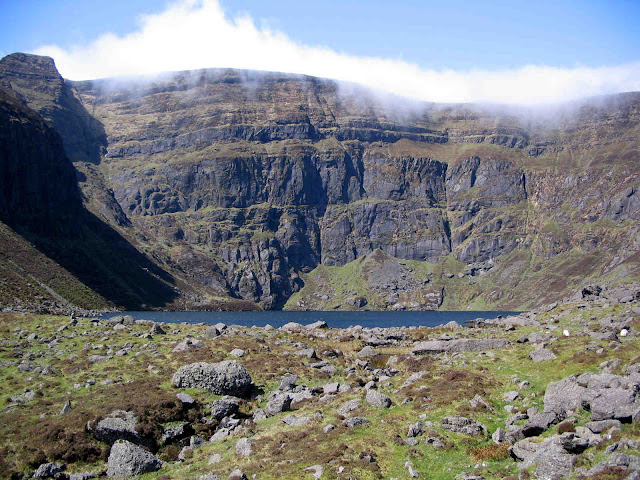 |
| Above Coum Mahon |
How many coums on the Comeraghs?
I mentioned the word “com” or “coum” in the last article. So, how many coums are there on the Comeraghs? Now, that`s a good question! Some people say 13, some say 14. In a recent book “Corries, Caves and Coast” by geologists Matthew Parks, Robert Meehan and Sophie Préteseille, the authors claim there are 18 or 19. There`s a big difference between 13 and 18. So which is it?
It all comes down to definition, I suppose. How do we define a coum? Many geography textbooks tell us that a coum is an armchair shaped hollow with steep back and side walls gouged into the mountainside by a glacier. It is in essence the birth place of a mountain glacier.
The defining characteristics of a bona fide, card carrying coum are:
Vertical Cliff Walls: These are found at the back and sides and are created by plucking of the rocks by the ice as gravity encourages it to move downslope.
Marshy Hollow sometimes occupied by a lake: Nivation or snow/ice patch erosion in sitú deepens the hollow over time as the sheer weight of ice and the constant freezing and thawing shatters the underlying bedrock. Whether a lake (which the Vikings called a “tarn”) develops or not depends on factors such as nature of the bedrock, level of the water table, underground springs etc.
Lip Moraine: This is an impounding or enclosing ridge of boulders and clay running across the mouth of the coum. It is the “open” wall of the coum and is created by the ice moving out of its birth hollow because of gravity and the creation of more ice higher up. As it leaves its mountain home the glacier drops many imbedded boulders at the mouth. The lip moraine is the “doorway” to the coum for us hill walkers.
Huge Boulders termed Erratics and Boulder Ridges termed Moraines: Geologists accept that ice is the only natural sculpting agent which has the necessary power to transport huge boulders long distances on land. Thus, individual boulders or ridges of boulders, be they lateral (parallel to the valley) or recessional (across the valley), are important defining characteristics of a coum.
 |
| An Seanbhean Waterfall above the Sgilloges |
Definitely Coums!
So, what coums pass the “defining characteristics” test? Lough Mohra and Coumduala on the eastern flank of Knockanaffrin Ridge definitely do, Coumlara, the Sgilloges, Coumalochas and Coumfea in the Nire ditto. Coumiarthar (or the Boolas), Crotty`s, Coumshingaun, Fáscoum, Coum Mahon and Coumtay on the south eastern and southern edges of the Comeragh Plateau also pass the test, as do Coum Knockaun and Coum Éag on the eastern flanks of the Monavullaghs. How many is that then? 14!
 |
| Coums Knockaun and Tay with Embryonic Coums |
Possible Coums?
So why do some people argue for 18/19? Well, Coumnagcapall, Coumdwane and Coumaraglin in the upper Colligan on the western slopes of the Monavullaghs have the “handle” coum and possess long valleys that may have been occupied by ice. However, they don`t have sheer cliffs on their back or side walls nor do they have many huge boulders nor much evidence of moraines. None of them possess the classic nivation hollow or impounding lip moraine. Another interesting “possible” coum is Faill an Phriosúin to the south of Fáscoum. The cliffs here are impressive enough and there are plenty erratics strewn about. There is even a lip moraine, however small. There is little evidence of a nivation hollow however and the feature has no depth with virtually no side walls. So, occupation by ice – yes, but this is at best an “immature” or "embryonic" coum. There wasn`t enough ice nor did it stay long enough to develop a fully fledged coum. There are hints of a few more embryonic coums here and there e.g. on the cliff wall to the west of Coum Tay. Another interesting study is that of Coum Knockaun. This is a complex cut on the eastern flank of Seefin Mountain, just west of Coum Knockaun. There are a number of significant walls and humps and hollows, so an argument could be made for two coums here, I suppose.So, after all that, how many coums do you think there are on the Comeraghs?



Comments
Post a Comment